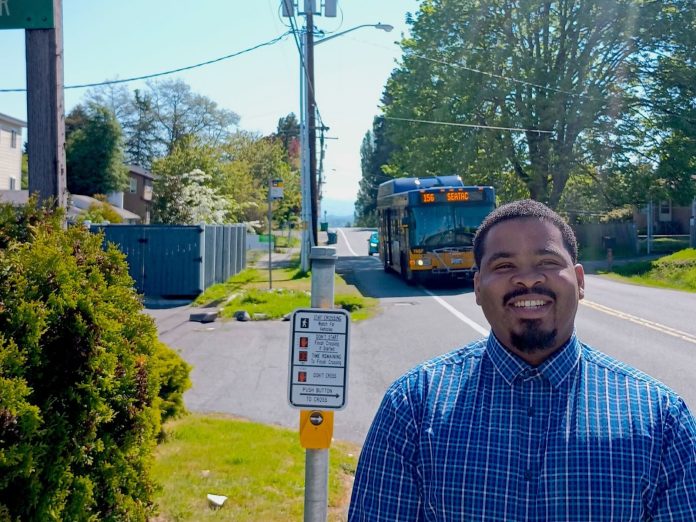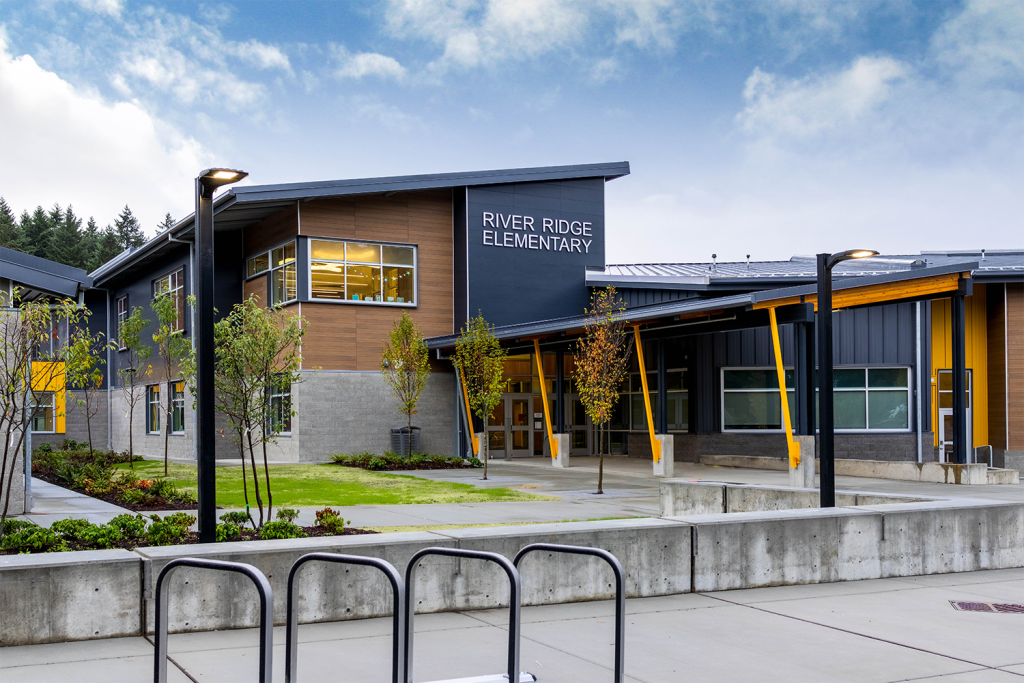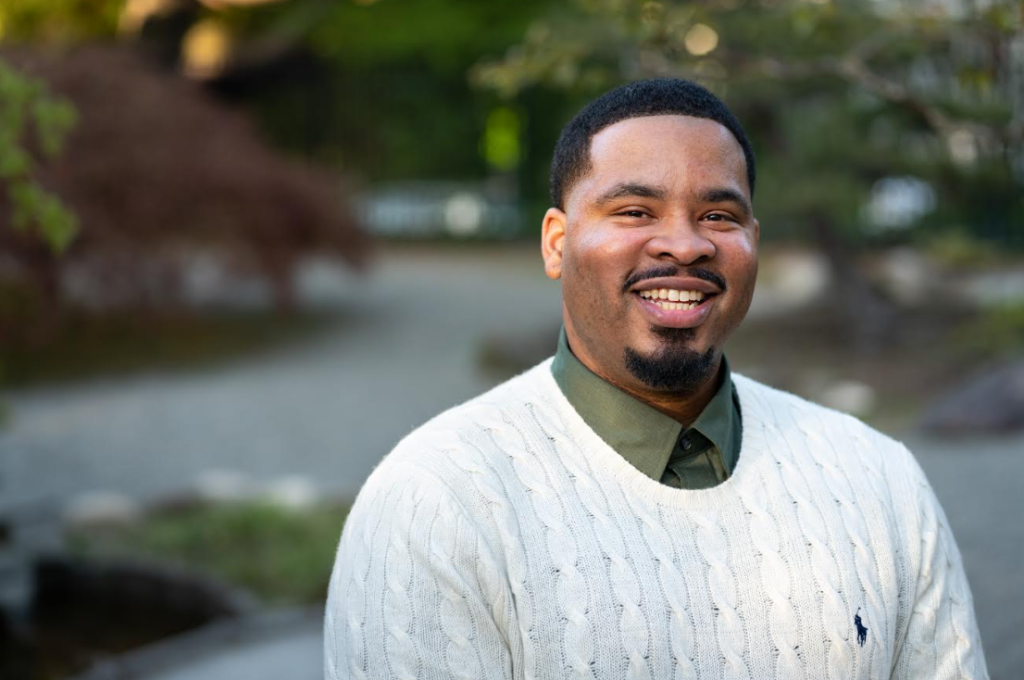
It all started with a sidewalk. Or rather, a lack of one.
When a brand new elementary school opened in his neighborhood, Joe Vinson looked at the levels of government that are supposed to work together but that had allowed the school to open without a safe way for kids to get there. Every day, he watched kids navigate along the side of a dangerous roadway instead, and knew we could do better. Now Vinson is running for city council in SeaTac, the city of 32,000 whose name is more commonly associated with the international airport next door.
In autumn of 2021, the Kent School District opened River Ridge elementary school. The $58 million school, with a capacity for nearly 900 students, largely serves families in Kent, but is located next door in the city of SeaTac. In planning River Ridge, the district did not assume that any kids at the school would walk or bike to campus — an assumption that turned out to be very wrong, given the number of nearby apartment buildings in SeaTac, many of which serve low-income residents. Around one in four students at River Ridge either live close enough to walk to school or beyond the reach of the bus service area. But there was no sidewalk to the school.
“It wasn’t until the project was complete, that I noticed we had elementary school-aged children walking on Military Road…it’s a two-way highway, you have tractor-trailers, construction equipment, people travelling to and from work at high rates of speed,” Vinson told me when we met at a SeaTac coffee shop earlier this spring. “You have these little kids walking along a shoulder — that’s all it is, just a shoulder, unprotected.”
In the end, SeaTac agreed to contribute some city funds to accelerate construction of the sidewalk along Military Road.

“It was due to me reaching out that they decided to take action,” Vinson said. “That was just a huge red flag.”
The City of SeaTac should have done a better job collaborating with the school district on how kids would get to school, he says, especially given the obvious danger the lack of sidewalks presented.
“That’s what lit the fire in me…okay, I’m noticing a trend, this sector of the city has a ton of immigrants, they’re underserved, they’re not represented, they don’t know who to contact.”
Vinson, a manager at the Seattle Department of Transportation (SDOT) overseeing the parking pay station shop, is clearly a transportation wonk, and his personal Twitter account echoes that of SDOT Director Greg Spotts, but with a focus on infrastructure in south King County.
“My current job has had a huge impacting influence on me on these issues,” he told me. “And I see the city of SeaTac can benefit from things that Seattle’s doing right, and some things Seattle may be doing wrong.” He specifically mentioned checklists that SDOT uses to quantify community outreach as one potential thing he could see adopting in SeaTac.
Vinson lives in the southeast corner of SeaTac, in an area of the city he notes is often overlooked and forgotten about, wedged in between Des Moines and Kent, and connects the issues at River Ridge to problems he’d had getting attention of SeaTac city staff on the periphery of the city. How would he change that? “Public outreach, community engagement: taking a second look at these projects and understanding who the stakeholders are. Just because it’s on the city limits doesn’t mean we just ignore the issue,” he said.
Vinson sees adding sidewalks and other basic transportation infrastructure to SeaTac’s neighborhood streets as a priority, noting that much of the maintenance and infrastructure upgrades in the city right now are contracted to King County. He’d like to look at whether SeaTac itself can staff up to take over some on of that work instead of sitting in the county’s queue.
When it comes to SeaTac’s most dangerous street, International Boulevard — a segment of deadly SR 99 that also exists as Aurora Avenue in Seattle and Pacific Highway in Snohomish County — he thinks south King County can learn from what other cities along the corridor are doing to improve traffic safety. Recently, the city of Edmonds advanced a design for a stretch of SR 99 that includes protected bike lanes, a first for the corridor.
“We can learn from the steps that they’ve taken to improve the corridor, because I do believe some of those problems exist down here in SeaTac as well, and we can definitely learn from that… they’ve spent X amount of money studying this, how can we apply some of those same metrics here to improve this for us,” Vinson said.

On the topic of housing, Vinson readily admits that the neighborhood where his family wanted to put down roots was Beacon Hill, not southeast SeaTac.
“I was priced out of Seattle, my wife and I, so we nestled down in the city of SeaTac, that was over a decade ago,” he said. “Come to SeaTac, we were able to have a yard. We were able to have a fence. So that struggle, for me, it’s something that resonated.” Watching his sister continue to pay rent on a Seattle apartment that is more than his mortgage, the issue became even more real to him.
Earlier this year, the SeaTac city council passed a rental protection ordinance, limiting move-in fees and requiring additional notice time for increases over 3%. Vinson supports the protections, but wants to see more buy-in from SeaTac landlords when it comes to adding laws protecting renters.
“I would prefer that the language is a little bit stronger, where we can have more community support,” he said. “I read the public comments and I didn’t see a whole lot of community support coming; [it was] primarily from the landlords. So how do we engage more with them to get that buy-in, because we need each other. I don’t want them to turn their rental homes into Airbnbs or sell the properties, because then we miss an opportunity for those who need the housing.”
Last year, Amazon announced that it would be providing funding for the construction of 85 dedicated affordable units at Angle Lake Station in SeaTac, in partnership with Mercy Housing Northwest. Vinson is eager to see how the project takes shape and begins to inform how to create transit-oriented affordable housing along the entire light rail line, being extended south from Angle Lake down to Federal Way.
Ultimately, it’s community engagement that’s driving Vinson’s campaign. The sidewalk project that inspired Vinson to run is finally moving forward. Just before Memorial Day, the Kent School Board approved the project again, after a cost increase of over $2 million from what had been given the green light last year. That final approval means that the new sidewalk should be ready to serve students by the start of the next school year this fall, two years after the school initially opened.
“Finally our concerns are being taken seriously and while I am extremely happy that this project is finally coming to fruition, I sincerely hope lessons have been learned from this situation,” Vinson said in a follow-up after the final approval. “The progress we’ve made as a community through persistence and advocacy has been able to make a real difference.”
Ryan Packer has been writing for The Urbanist since 2015, and currently reports full-time as Contributing Editor. Their beats are transportation, land use, public space, traffic safety, and obscure community meetings. Packer has also reported for other regional outlets including BikePortland, Seattle Met, and PubliCola. They live in the Capitol Hill neighborhood of Seattle.

